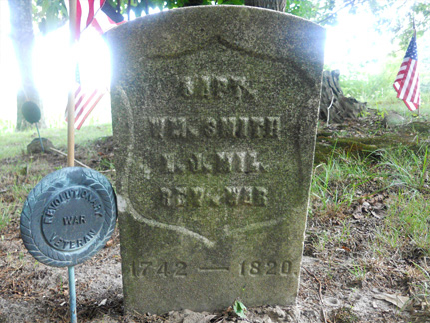




Quinton's Bridge
at Alloways Creek
Rte. 49 at Quinton-Alloway Rd.
Map / Directions to Quinton's Bridge
Map / Directions to all Quinton Revolutionary War Sites
In March 1778, a group of about 1500 British troops under the command of Charles Mawhood occupied the town of Salem. Their objective was to confiscate cattle, hay, and corn to bring across the Delaware River to Philadelphia, which was then controlled by the British. (See the Salem page for more information about the occupation of Salem.)
Local citizens had moved some of the cattle south of Salem, past Alloways Creek to keep it from the British. Alloways Creek extends about thirty miles inland from the Delaware River, creating a natural southern boundary that could only be crossed at three bridges in the area: Quinton's Bridge, Hancock's Bridge about four miles east of here, and Thompson's Bridge about five miles to the west. Salem and Cumberland County militiamen took positions at the bridges to stop the British from moving past them.
The British made an attack on Quinton's Bridge on March 18. During the attack, the British lured about 200-300 of the militiamen across the bridge into an ambush feigning a retreat. The British had actually hidden some of their soldiers in a house near the creek, and when the militiamen moved past them, the soldiers rushed out of the house to cut off the militiamen's retreat to the bridge. Militiamen were captured or killed, but their defense of the bridge held, and the British were not able to cross Alloways Creek at Quinton's Bridge.[1]
Three days later an attack was made on the militiamen at Hancock's Bridge, in which militiamen were bayoneted to death in their sleep in a nearby house. See the Hancock's Bridge page for details.



Captain William Smith Homestead Site
Quinton's Bridge Memorial
Rte. 49, across from Cottage Ave.
Map / Directions to Smith's Homestead
Map / Directions to all Quinton Revolutionary War Sites
Located about a hundred yards from the site of the bridge, this memorial stands at the site of the homestead of Captain William Smith, who was one of the militiamen defending the bridge. The memorial pays tribute to Captain Smith and the others who fought at the Battle of Quinton's Bridge. [2]
Captain Smith's farmland extended to the south. He is buried in a small cemetery on part of what was his farmland, about three miles down Jericho Road, along with men who died at the Battle of Quinton's Bridge. (See next entry.)




Captain William Smith's Farm
Revolutionary War Cemetery
Jericho Rd.
Map / Directions to Captain William Smith's Farm
Map / Directions to all Quinton Revolutionary War Sites
This small cemetery sits on what was once the farm property of Captain William Smith. He was buried here in 1820.
There are also a number of soldiers who were killed at the Battle of Quinton's Bridge buried here, but the exact number and their identities are not known. Only Captain Smith's gravestone has a name on it. [3]

1. ^ • John Graves Simcoe, Simcoe's Military Journal (New York: Bartlett & Welford, 1844) pages 46 - 54
Available to be read at Google Books here
• Robert Gibbon Johnson, An Historical Account of the First Settlement of Salem, in West Jersey (Philadelphia, Orrin Rogers, 1839) Pages 141 - 142
▸ ▸ While the sign at the bridge states that seven militiamen died in the retreat, Johnson reports a "loss of between thirty and forty." Johnson was a resident of Salem who published his book seven decades after the event. He was presumably relying at least in part on local tradition for his information.
Simcoe was serving as a Major under Colonel Mawhood at the time of the attack on Quinton's Bridge, and so was writing from first-hand experience. He does not give numbers of the casualties, but he writes that "some of the division who passed the house, were taken prisoners, but the greater part were drowned in the Aloes [Alloways] creek."2. ^ Memorial erected by Oak Tree Chapter Daughters of the American Revolution, Salem NJ, October 17, 1908
3. ^ Information drawn from the Captain William Smith's Farm sign at the entrance of the cemetery.